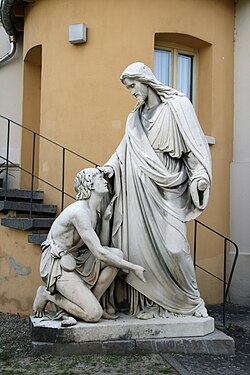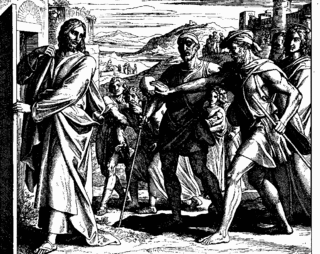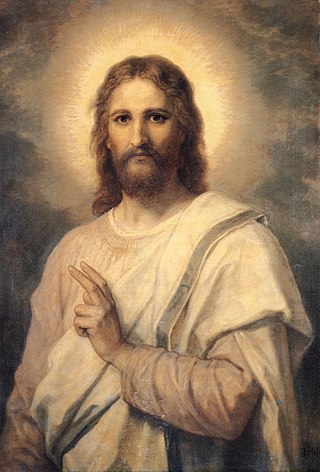Bartimaeus |
|---|

Bartimaeus was a man in the Bible who was blind for much of his life. According to the Gospel of Mark, Bartimaeus called out to Jesus Christ to be healed, and Jesus gave him sight. [1] [2]
Bartimaeus |
|---|

Bartimaeus was a man in the Bible who was blind for much of his life. According to the Gospel of Mark, Bartimaeus called out to Jesus Christ to be healed, and Jesus gave him sight. [1] [2]

The Gospel of Mark is the second of the four canonical Gospels and one of the three synoptic Gospels. It tells of the ministry of Jesus from his baptism by John the Baptist to his death, the burial of his body, and the discovery of his empty tomb. It portrays Jesus as a teacher, an exorcist, a healer, and a miracle worker, though it does not mention a miraculous birth or divine pre-existence. Jesus refers to himself as the Son of Man. He is called the Son of God but keeps his messianic nature secret; even his disciples fail to understand him. All this is in keeping with the Christian interpretation of prophecy, which is believed to foretell the fate of the messiah as suffering servant.
A Bible conspiracy theory is any conspiracy theory that posits that much of what is believed about the Bible is a deception created to suppress a secret or ancient truth. Some such theories claim that Jesus really had a wife and children, or that a group such as the Priory of Sion has secret information about the true descendants of Jesus; some claim that there was a secret movement to censor books that truly belonged in the Bible, etc.

The Gospel of John is a 2003 epic biblical drama film that recounts the life of Jesus according to the Gospel of John. The film is a word-for-word adaptation of the American Bible Society's Good News Bible and follows the Gospel of John precisely, without additions to the story from the other Gospels or omissions of the Gospel's complex passages. It stars Henry Ian Cusick as Jesus of Nazareth, Stuart Bunce as John and is narrated by Christopher Plummer.

Two names and a variety of titles are used to refer to Jesus in the New Testament. In Christianity, the two names Jesus and Emmanuel that refer to Jesus in the New Testament have salvific attributes. After the crucifixion of Jesus the early Church did not simply repeat his messages, but focused on him, proclaimed him, and tried to understand and explain his message. One element of the process of understanding and proclaiming Jesus was the attribution of titles to him. Some of the titles that were gradually used in the early Church and then appeared in the New Testament were adopted from the Jewish context of the age, while others were selected to refer to, and underscore the message, mission and teachings of Jesus. In time, some of these titles gathered significant Christological significance.

The miracles of Jesus are miraculous deeds attributed to Jesus in Christian and Islamic texts. The majority are faith healings, exorcisms, resurrections, and control over nature.

"Jesus wept" is a phrase famous for being the shortest verse in the King James Version of the Bible, as well as in many other translations. It is not the shortest in the original languages. The phrase is found in the Gospel of John, chapter 11, verse 35. Verse breaks—or versification—were introduced into the Greek text by Robert Estienne in 1551 in order to make the texts easier to cite and compare.

The Blind Man of Bethsaida is the subject of one of the miracles of Jesus in the Gospels. It is found only in Mark 8:22–26. The exact location of Bethsaida in this pericope is subject to debate among scholars but is likely to have been Bethsaida Julias, on the north shore of Lake Galilee.

Mark 10 is the tenth chapter of the Gospel of Mark in the New Testament of the Christian Bible. It presents further teachings of Jesus as his journey progresses beyond the River Jordan and towards Jerusalem. Verses 1-31 deal with the themes of marriage, children and possessions, while verses 31-52 look ahead again to Jesus' passion and true service, and conclude with a further healing of a blind man, comparable to a similar healing in Mark 8.

The New Testament narrative of the life of Jesus refers to several locations in the Holy Land and a Flight into Egypt. In these accounts the principal locations for the ministry of Jesus were Galilee and Judea, with activities also taking place in surrounding areas such as Perea and Samaria. Other places of interest to scholars include locations such as Caesarea Maritima where in 1961 the Pilate stone was discovered as the only archaeological item that mentions the Roman prefect Pontius Pilate, by whose order Jesus was crucified.
John 9 is the ninth chapter of the Gospel of John in the New Testament of the Christian Bible. It maintains the previous chapter's theme "Jesus is light", recording the healing of an unnamed man who had been blind from birth, a miracle performed by Jesus, and their subsequent dealings with the Pharisees. The man born blind comes to complete faith in Jesus, while some of the Pharisees remain in their sin. The author of the book containing this chapter is anonymous, but early Christian tradition uniformly affirmed that John composed this Gospel.

John 12 is the twelfth chapter of the Gospel of John in the New Testament of the Christian Bible. It narrates an anointing of Jesus' feet, attributed to Mary of Bethany, as well as an account of the triumphal entry of Jesus Christ into Jerusalem. The author of the book containing this chapter is anonymous, but early Christian tradition uniformly affirmed that John composed this Gospel.

Luke 14 is the fourteenth chapter of the Gospel of Luke in the New Testament of the Christian Bible. It records one miracle performed by Jesus Christ on a Sabbath day, followed by his teachings and parables, where he "inculcates humility ... and points out whom we should invite to our feasts, if we expect spiritual remuneration". The book containing this chapter is anonymous, but early Christian tradition uniformly affirmed that Luke the Evangelist composed this Gospel as well as the Acts of the Apostles.
Luke 18 is the eighteenth chapter of the Gospel of Luke in the New Testament of the Christian Bible. It records the teachings and a miracle of Jesus Christ. The book containing this chapter is anonymous, but early Christian tradition uniformly affirmed that Luke the Evangelist composed this Gospel as well as the Acts of the Apostles.

Each of the three Synoptic Gospels tells of Jesus healing the blind near Jericho, as he passed through that town, shortly before his passion.

Karunamayudu is a 1978 Indian Telugu-language biographical film written and directed by A. Bhimsingh. It stars Vijayachander as Jesus of Nazareth. The film won two Nandi Awards, was notable for two song sequences narrating the Birth of Jesus and Entry into Jerusalem, the film was screened at the International Film Festival of India.

The following outline is provided as an overview of and topical guide to Christianity:

The miracle of healing the man born blind is one of the miracles of Jesus in the Gospels, in which Jesus restored the sight of a man at Siloam. Although not named in the gospel, church tradition has ascribed the name Celidonius to the man who was healed. The account is recorded in the ninth chapter of the Gospel of John.

Jesus healing two blind men is a miracle attributed to Jesus in the Gospel of Matthew. It follows immediately on the account of the Daughter of Jairus.

The following outline is provided as an overview of and topical guide to Wikipedia articles on the life and influence of Jesus.

Kees de Kort was a Dutch artist best known for his illustrations of Bible scenes for children's books.